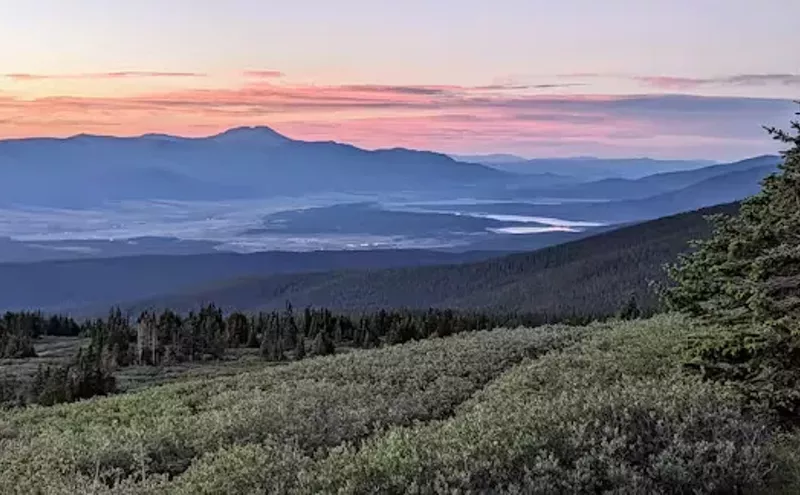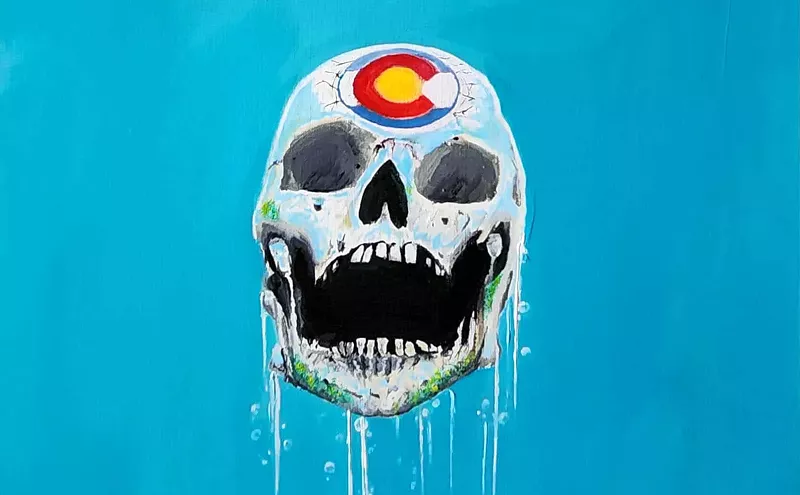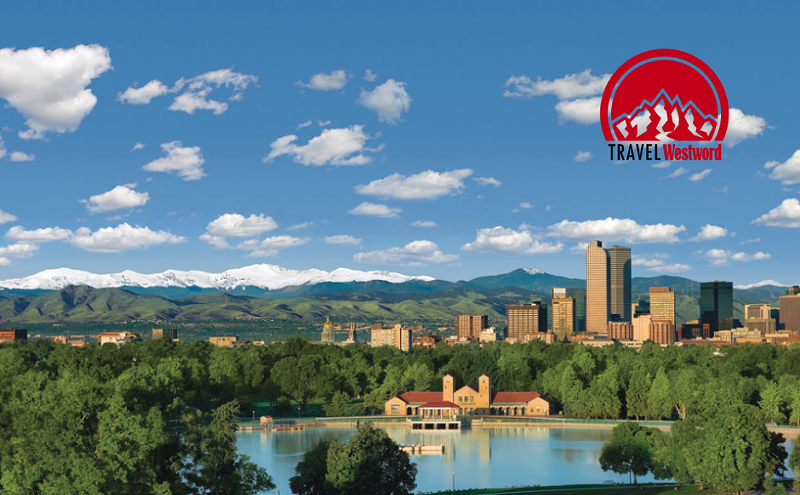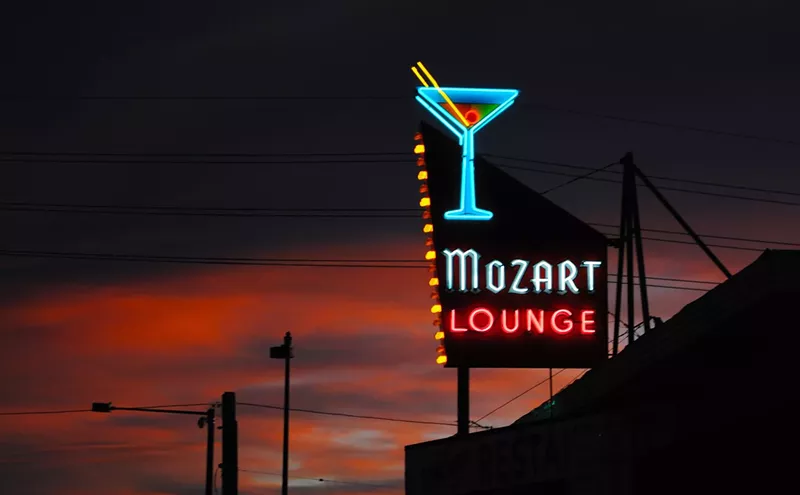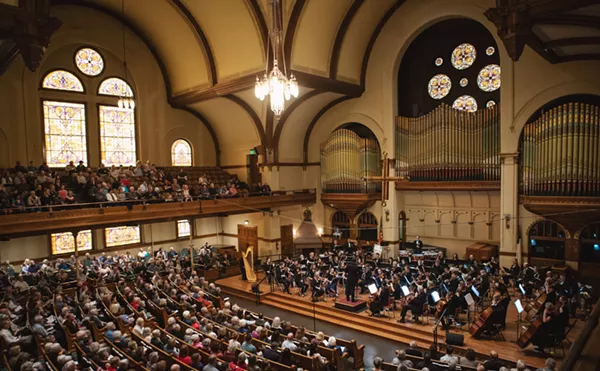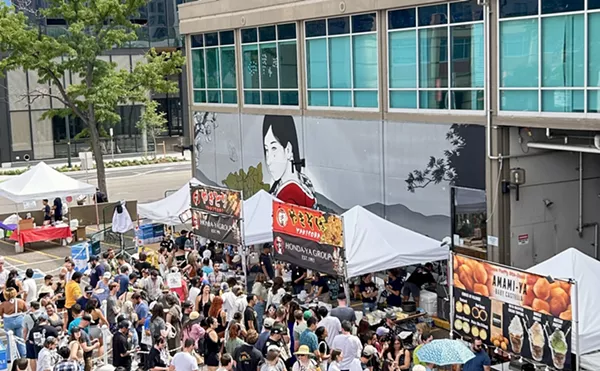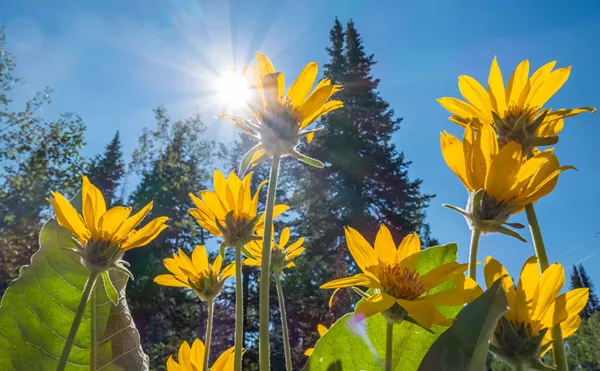Walking along Santa Fe Drive the other day, I gazed at the van Straaten Gallery and thought about a shift that has taken place recently on the street. As usual, the gallery was closed, though a few spotlights were on so you could tell there was art on display inside.
The first indication that things weren't going well came earlier this year, when owners Jan and Bill van Straaten let go of gallery director William Biety and cut the hours to appointment-only. And now the space is up for sale. Truth be told, there are many spaces along Santa Fe that are for sale. What makes this one different is what this gallery meant to the art district. Not only was its predecessor, the Sandy Carson Gallery, the premier gallery on the row, but it was one of the first commercial spaces to stake a claim here in the 1990s. Many in the art community hoped the van Straatens would continue to make it a top spot for local, regional and national artists. But it's not to be.
I would now dub Space Gallery the district's top commercial venue. Owner Michael Burnett has a good eye for art and a capacious set of rooms in which to display it. In the main gallery right now is a fascinating show, New Works by Diane Cionni, which is made up of paintings depicting blurry, abstracted views of plants.
Cionni, who lives in Steamboat Springs, has been a practicing artist for thirty years, but this is a rare glimpse of her work in Denver. For these pieces, she took photos of her garden and then digitally altered them. Afterward, using rice paper, inks and acrylic pigments, she obscured the details of the original pictures while enhancing their outlines. The finished products, such as "Dandy," are clearly paintings as opposed to painted photographs, but you can still see the digital origins of the imagery.
They remind me of the similarly conceived (if otherwise different) work by Bob Koons, and I thought how great it would be to put Cionni in a duet with him. Koons, by the way, used to show at Sandy Carson, which is where I first saw his work.
In the rear gallery, Burnett has installed Holiday Group Show, highlighting Space's strength in contemporary abstraction. There are some amazing paintings by Scott Holdeman that juxtapose blurry organic shapes against straight lines and bars, all of it sealed under unifying layers of shiny glazes. The large Haze Diedrich is another standout. Among the other included artists are Michael McClung, who burns through his pieces to create them; Robin Ault, who did some very Franz Kline-like drawings on sheet music; and Tom Bosma, who's represented by a trio of mixed-media neo-minimalist compositions. Also here are updated abstract-expressionist works by Carlene Frances and Pat Orban, who run the Enso Gallery on the mezzanine.
Last but hardly least is Lewis McInnis, who's represented by more than half a dozen gouaches that are absolutely fabulous. They are dense little gems covered in spontaneous markings. I think of McInnis as being one of the top abstract painters around today, and these drawings prove it. It's hard to understand why he's so little known.
That's the same query I'd make about the artist whose solo, Abstraction 2010: Ania Gola-Kumor, is on view at the nearby Sandra Phillips Gallery. Gola-Kumor has been exhibiting in Denver for decades; her signature style is all-over abstractions formed from clearly defined shapes that fill the picture plane to the edges, like the pieces of an enigmatic puzzle. Her painterly technique is breathtaking, with lots of overpainting in broken passages across the picture that is emphasized by a sense for drawing, as though Gola-Kumor had scribbled across the canvases and then carefully filled in the resulting automatist forms with layer upon layer of pigment — which is precisely what she did. The automatism links her to abstract expressionism, while the meditative followup makes her approach distinctly different.
Gola-Kumor's palettes are remarkable and unerring in their elegant balance. The paintings in this group are closely associated formally, but not in terms of their colors, which, though defined by a limited range within each piece, encompass the entire spectrum of color across the series. Some are filled with hot, toned-up reds and oranges, while others are in cool, recessive shades of creams and greens; all are untitled.
Despite the small space, director Sandra Phillips has shoehorned in another solo, New Work: Andrew Speer. Speer, who's had a long art and teaching career in the area, would be the state's most idiosyncratic painter if Ken Peterson didn't live here, too. His approach is invariably experimental, and these recent paintings are dominated by juxtapositions of different forms and styles. The effect is jarring. Another difficult aspect of his work is his taste for muddy color fields used as backdrops. Speer's paintings clash with Gola-Kumor's, and I wish Phillips had more effectively separated them.
The Art District on Santa Fe is still Denver's top art area, but a larger, up-and-coming district is giving it a run for its money: the River North district, nicknamed (trade named?) RiNo. A marker in the form of a geometric rendition of a rhinoceros — get it? — has just been placed as an entry piece to the neighborhood on the corner of Broadway and Larimer Street. Made by California artist Mike Whiting, it is marvelous, both severe and whimsical at the same time. Its shape, with four cubic sides, follows the silhouette of the animal, with a square through-piercing to indicate the creature's eyes. The surfaces have a painterly finish in the form of distressed automotive lacquer in a faded blue.
I think the piece is great, though I do wish it had been a more appropriate animal for our region. Some years ago, Whiting displayed a buck and a doe done in this same way, and those would have linked the work to the context of the American West, which the rhino decidedly doesn't. It does, however, fit into the blue-animal subject-matter context in Denver's public sculpture, which include the blue bear at the Colorado Convention Center and the blue mustang out at DIA.
Farther down Broadway, at Walnut Street, is a two-part Whiting sculpture, "Pinkie and Mr. Green," which is done in the same style and depicts a conventionalized woman and man. The piece is near Plus Gallery, where owner Ivar Zeile is presenting the solo Primitives: New Sculpture by Mike Whiting, a temporary salute to the artist that coincides with the permanent installation of his pieces nearby.
The works in the show are somewhat different than "Rhino" and "Pinkie and Mr. Green" in that they are more formally complex, and more abstract. And though they are post-minimal, like a cross between Joel Shapiro and Donald Judd, they do make oblique references to primitive cultures. Several carry the title "Mask." The "Pyramid of the Rabbit," a geometric rabbit's head on a pyramid, and "Pyramid of the Cock," a rooster's head on a pyramid, bring in a reference to Meso-American art, but in a very abstract way.
The surfaces of these new pieces are different, too, with the automotive lacquers having been more heavily abused than before by being scuffed, ground down and repainted. A number of them look as though they've been vandalized by taggers. The results are a complicated array of colors that sometimes change as the planes of the forms do. It's so unlike the consistent color of "Rhino," with its monochrome of light blue — well, at least until the real taggers take their spray paint to it.
While "Rhino" and "Pinkie and Mr. Green" will be on view for a long time, Primitives will not, and it's definitely worth seeing, in particular because it indicates an advancement and a new direction for an artist whose work is now a part of Denver.


